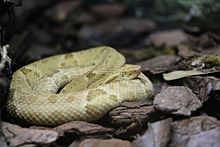Bothrops insularis
| Bothrops insularis | |
|---|---|
 |
|
| Scientific classification | |
| Kingdom: | Animalia |
| Phylum: | Chordata |
| Class: | Reptilia |
| Order: | Squamata |
| Suborder: | Serpentes |
| Family: | Viperidae |
| Genus: | Bothrops |
| Species: | B. insularis |
| Binomial name | |
|
Bothrops insularis (Amaral, 1922) |
|
| Synonyms | |
|
|
Bothrops insularis, commonly known as the golden lancehead, is a venomous pit viper species endemic to Ilha da Queimada Grande, off the coast of São Paulo state, in Brazil. The species is named for the light yellowish-brown color of its underside and for its head shape which is characteristic of the genus Bothrops. No subspecies of Bothrops insularis are currently recognized.
On average B. insularis grows to a length of 70 cm (28 in) and is known to reach 118 cm (46 in). The color pattern consists of a pale yellowish-brown ground color, overlaid with a series of dorsal blotches that may be triangular or quadrangular, broad or narrow, and alternating or opposite along the dorsal median. In captivity, this yellowish color often becomes darker, which may be the result of poor circulation caused by ineffective thermoregulation. A banded pattern results when the pattern is opposite. The head lacks a well-defined post-orbital stripe. The belly is a uniform pale yellow or cream.
The name "lancehead" refers to the distinctive head shape of all snakes in the genus Bothrops, which is somewhat elongated and comes to a point at the nose.B. insularis also has a longer tail than its closest relative, B. jararaca, which is most likely an adaptation to help the snake maneuver through the trees.
Because B. insularis is only found in an area uninhabited by humans, there has never been an official report of a human being bitten by one, but other lanceheads are responsible for more human mortality than any other group of snakes in either North or South America. Ludwig Trutnau reports four human envenomations, three of which were fatal. The mortality rate for lancehead envenomations is 0.5–3% if the patient receives treatment and 7% if the patient does not receive treatment. The effects of envenomations by lanceheads include swelling, local pain, nausea and vomiting, blood blisters, bruising, blood in the vomit and urine, intestinal bleeding, kidney failure, hemorrhage in the brain and severe necrosis of muscular tissue. Chemical analysis of the venom of B. insularis suggests that it is five times as potent as that of B. jararaca and is the fastest acting venom in the genus Bothrops. They have hemotoxic venom that eats away at flesh and tissue to digest the prey item before they swallow it. Bothrops insularis also have some neurotoxic venom that kills the prey item.
...
Wikipedia

